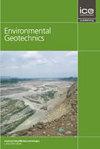Rocking Motion Analysis Using Structural Identification Tools
IF 2.2
4区 工程技术
Q3 ENGINEERING, GEOLOGICAL
引用次数: 0
Abstract
This research investigates the convenience of structural identification tools to detect the rocking motion tendency, using as input the structural response to ambient vibrations. The rocking ratio and rocking spectrum are proposed as original tools to highlight the rocking motion and its frequency content. The proposed procedure allows the detection and quantification of rocking using only building vertical motion records in both cases of ambient vibration and earthquake. First, three-dimensional finite element models of reinforced concrete buildings are adopted to simulate the structural response to white noise vibration. Different low- and high-rise buildings are studied, having framed structure and frame–wall system, regular and irregular structure, shallow foundation and underground floors. The structural response obtained numerically is analyzed using different signal processing tools to obtain the dynamic features of buildings, and the rocking motion tendency is identified by comparison with a reference fixed base condition. Then, the reliability of the proposed methodology to detect rocking motion attitude, using only the structural motion, is verified and quantified using the proposed tools. Finally, the same approach is applied to real structural motion records of a high-rise reinforced concrete building.使用结构识别工具进行摇摆运动分析
本研究将结构对环境振动的响应作为输入,探讨结构识别工具检测摇摆运动趋势的便利性。提出了用摆动比和摆动谱作为显示摆动运动及其频率内容的原始工具。所提出的程序允许在环境振动和地震两种情况下仅使用建筑物垂直运动记录来检测和量化摇摆。首先,采用钢筋混凝土建筑三维有限元模型,模拟结构对白噪声振动的响应。研究了不同的低层和高层建筑,有框架结构和框架-墙体系,规则和不规则结构,浅基础和地下楼板。采用不同的信号处理工具对数值计算得到的结构响应进行分析,得到建筑物的动力特征,并与参考固定基础条件进行对比,识别出建筑物的摇摆运动趋势。然后,使用所提出的工具验证并量化了仅使用结构运动来检测摇摆运动姿态的方法的可靠性。最后,将同样的方法应用于某高层钢筋混凝土建筑的实际结构运动记录。
本文章由计算机程序翻译,如有差异,请以英文原文为准。
求助全文
约1分钟内获得全文
求助全文
来源期刊

Environmental geotechnics
Environmental Science-Water Science and Technology
CiteScore
6.20
自引率
18.20%
发文量
53
期刊介绍:
In 21st century living, engineers and researchers need to deal with growing problems related to climate change, oil and water storage, handling, storage and disposal of toxic and hazardous wastes, remediation of contaminated sites, sustainable development and energy derived from the ground.
Environmental Geotechnics aims to disseminate knowledge and provides a fresh perspective regarding the basic concepts, theory, techniques and field applicability of innovative testing and analysis methodologies and engineering practices in geoenvironmental engineering.
The journal''s Editor in Chief is a Member of the Committee on Publication Ethics.
All relevant papers are carefully considered, vetted by a distinguished team of international experts and rapidly published. Full research papers, short communications and comprehensive review articles are published under the following broad subject categories:
geochemistry and geohydrology,
soil and rock physics, biological processes in soil, soil-atmosphere interaction,
electrical, electromagnetic and thermal characteristics of porous media,
waste management, utilization of wastes, multiphase science, landslide wasting,
soil and water conservation,
sensor development and applications,
the impact of climatic changes on geoenvironmental, geothermal/ground-source energy, carbon sequestration, oil and gas extraction techniques,
uncertainty, reliability and risk, monitoring and forensic geotechnics.
 求助内容:
求助内容: 应助结果提醒方式:
应助结果提醒方式:


